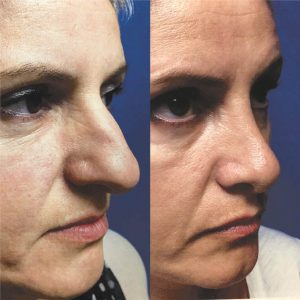By Gunnar Bergqvist, MD
 Rhinoplasty stems from the Latin words rhino (nose) and plasty (to form or shape). Rhinoplasties have a rich history in human culture. Originating as a punishment for theft in ancient Egypt in the form of rhinectomy, the reconstruction of noses truly began in 500 BC under Shushruta, a doctor credited to inventing the forehead flap. In the Roman empire, rhinoplasties and other cosmetic procedures were referenced, especially the reconstruction of noses due to birth defects
Rhinoplasty stems from the Latin words rhino (nose) and plasty (to form or shape). Rhinoplasties have a rich history in human culture. Originating as a punishment for theft in ancient Egypt in the form of rhinectomy, the reconstruction of noses truly began in 500 BC under Shushruta, a doctor credited to inventing the forehead flap. In the Roman empire, rhinoplasties and other cosmetic procedures were referenced, especially the reconstruction of noses due to birth defects
Italians were performing rhinoplasties on soldiers returning from war in the 1500s. Since the end of the 19th century there have been great advancements in the cosmetic procedure as surgeons have honed their skills and expanded their understanding of the structure and functions of the nose.
A common misconception is that this is always a cosmetic procedure, however this is not always the case. There are cosmetic, functional, or restorative rhinoplasties, each serving a specific purpose. A cosmetic rhinoplasty is done to alter the shape and appearance of your nose. A reconstructive is done for the purpose of restoring the function of the nose. Lastly, a restorative rhinoplasty is done to give one back their nose in the instance of trauma or disease. It is important that no matter what type of rhinoplasty one does, that they consider the primary functions of nose and make sure that the result restore each of these functions to the maximum capability.
According to Dr. Bergqvist, there are six primary functions of the nose that must be considered. The primary is to breathe, to work as a conduit to your lungs while your mouth is closed. Second, and another obvious function, is that of smell. This is extended to facilitate your sense of taste, the third function. Inside of the nose you have several protrusions which create moisture for your airways, these are called turbinates. Without these structures and the moisture, they provide, your lungs would become damaged by the dry air. The nose also helps to filter dust, and particles out of the air functioning as one of your body’s primary defenses against foreign bodies. The last function is to look good.
One of the most important aspects of any surgery of the nose, is to go back to the 6 function of the nose and restore each as much as possible. While not always the objective the outcome typically corresponds to an aesthetically pleasing nose.
While considering the functions of the nose, one must also consider the overarching structural complexity. While the exterior of the nose consists of many intricate aesthetic units, the nose as a whole is composed of many tissues- skin cartilage, bone, connective and neural tissue. One of the more intricate structures in the nose which require surgery are the valves. The nose has multiple air valves, the external consisting of the nostril. If this is having issues with collapse, this can be reconstructed to help breathing.
The internal nasal valve is one of the most commonly missed structure of the nose, and if collapsed can cause you difficulty with breathing. This valve can be reconstructed to stay open. Behind this valve, the next level of air obstruction would be the septum. The septum has a primary function of maintaining the height of your nose. It is not uncommon that the septum may be bent or broken or have a hematoma after trauma. Each of these may be referred to as a deviated septum. This reconstruction more commonly known as a septoplasty. This is also typically done in conjunction with turbinate surgery to improve breathing.
Now more than ever rhinoplasties are fulfilling more than one purpose. Attached are the before and after images of a patient who underwent cosmetic and functional reconstruction by Dr. Bergqvist. Typical recovery varies patient from patient. However, should you consider a rhinoplasty you should expect bruising for 1-3 weeks (bruising may persist should you require structural repositioning), and swelling to subside within several weeks.
Gunnar Bergqvist, MD
The Plastic Surgery Center of Naples
860 111th Ave., N., Suite #6, Naples Florida, 34108
239.431.7967 | www.SwedishDr.com








